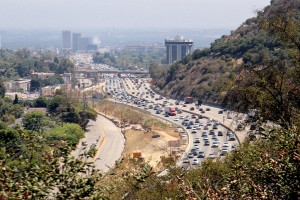 The story is fairly well known: Los Angeles used to have one of the biggest public transportation systems in the world, with the Red and Yellow trolley cars delivering people from their “streetcar subdivision” homes to the city center and beyond. But the automobile — and not an automaker conspiracy — proved more appealing to Angelenos than sitting on a crowded, tardy, and unreliable streetcar. And thus the system fell into disrepair, disuse, and extinction.
The story is fairly well known: Los Angeles used to have one of the biggest public transportation systems in the world, with the Red and Yellow trolley cars delivering people from their “streetcar subdivision” homes to the city center and beyond. But the automobile — and not an automaker conspiracy — proved more appealing to Angelenos than sitting on a crowded, tardy, and unreliable streetcar. And thus the system fell into disrepair, disuse, and extinction.
Curbed LA delves back into this history and helps dispel the myth that car companies undid the streetcars. In the piece, reporter Elijah Chiland asked me if anything could have been done to avoid abandoning the trolley streetcars in favor of the short-lived functionality of the automobile:
Elkind says the streetcar still could have been saved, but that “it would have taken some imagination and foresight on the part of the public to think, ‘what if we did subsidize this transit service? We might be able to address some of the problems that we have and make it a better service.'”
For whatever reason, that just didn’t happen. “The leadership wasn’t there and the foresight wasn’t there,” he says.
In the matter of the streetcar’s untimely demise, we Angelenos may have no one to blame but ourselves.
 Chiland asked a good question. Certainly many European cities decided not to ditch their streetcars during the post-war era, and they are now better off for it (although most American cities did abandon theirs, from Washington DC to the Bay Area).
Chiland asked a good question. Certainly many European cities decided not to ditch their streetcars during the post-war era, and they are now better off for it (although most American cities did abandon theirs, from Washington DC to the Bay Area).
But during a brief moment in the history of the rise of the automobile, Downtown Los Angeles officials experimented with ditching the automobile during peak hours. In the 1920s, they issued a short-lived ban on parking during certain daytime hours. But the public (and downtown business leaders) rebelled, and the policy was scrapped. During that time though when car parking was banned, streetcars evidently regained their prominence downtown and avoided the sometimes 60-minute delays caused by car traffic halting the trains, which had undermined rail service and contributed to its unpopularity.
So local policies on critical automobile issues like parking, as well as support for auto-oriented infrastructure, ultimately sealed the streetcars fate.
It’s too bad, because now Los Angeles is trying to rebuild much of that streetcar system at a huge cost, while also trying to retrofit existing car-oriented neighborhoods into more compact, walkable development. It’s hard to undo what’s already been done, but a growing population and demand for new housing presents the region with an opportunity to correct some of these past mistakes.


